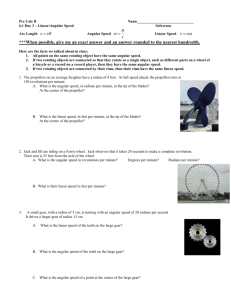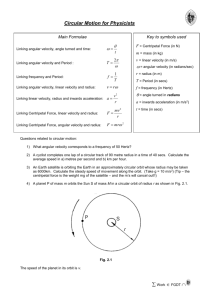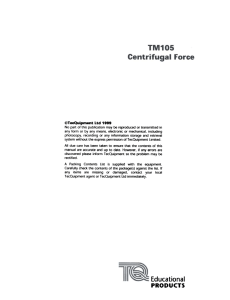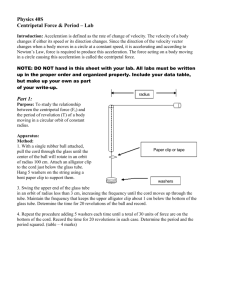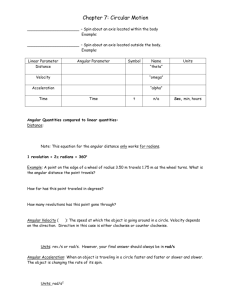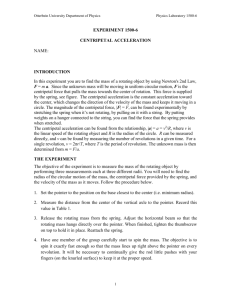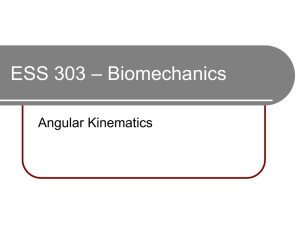Uniform Circular Motion
advertisement
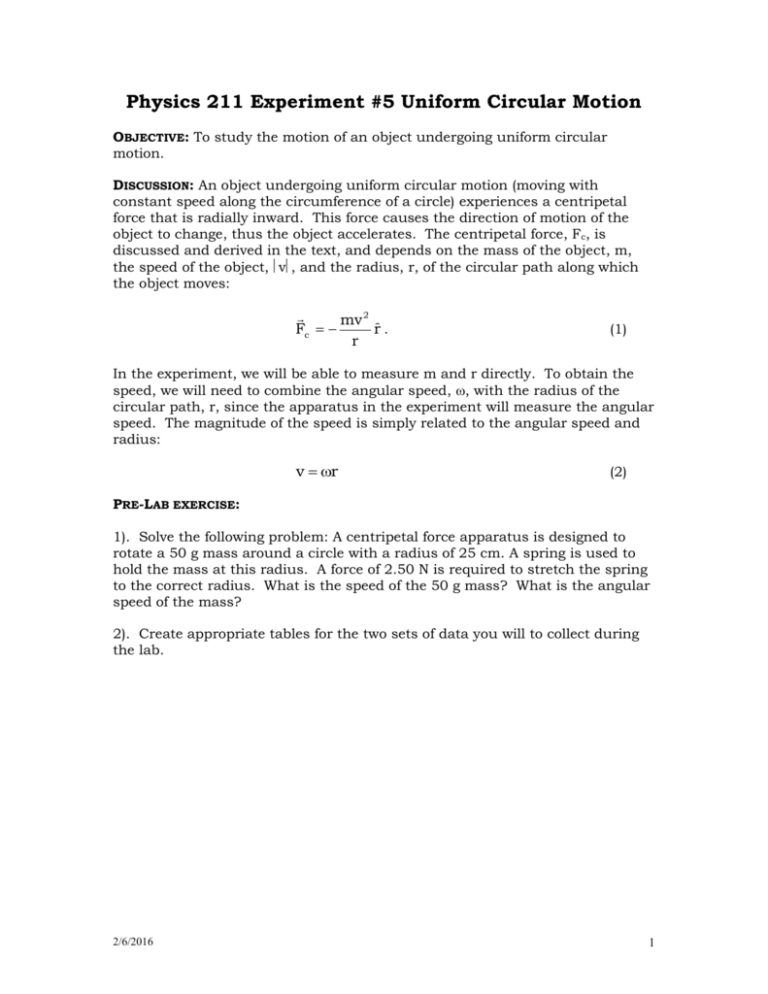
Physics 211 Experiment #5 Uniform Circular Motion OBJECTIVE: To study the motion of an object undergoing uniform circular motion. DISCUSSION: An object undergoing uniform circular motion (moving with constant speed along the circumference of a circle) experiences a centripetal force that is radially inward. This force causes the direction of motion of the object to change, thus the object accelerates. The centripetal force, Fc, is discussed and derived in the text, and depends on the mass of the object, m, the speed of the object, v, and the radius, r, of the circular path along which the object moves: mv 2 ˆr . Fc r (1) In the experiment, we will be able to measure m and r directly. To obtain the speed, we will need to combine the angular speed, , with the radius of the circular path, r, since the apparatus in the experiment will measure the angular speed. The magnitude of the speed is simply related to the angular speed and radius: v r (2) PRE-LAB EXERCISE: 1). Solve the following problem: A centripetal force apparatus is designed to rotate a 50 g mass around a circle with a radius of 25 cm. A spring is used to hold the mass at this radius. A force of 2.50 N is required to stretch the spring to the correct radius. What is the speed of the 50 g mass? What is the angular speed of the mass? 2). Create appropriate tables for the two sets of data you will to collect during the lab. 2/6/2016 1 Overview In this experiment, we will measure the force exerted on a spring in two different ways: the force, F, due to gravity on a mass attached to the spring for a non-rotating system, and the centripetal force due to a rotating mass. In the experiment, we will arrange it so the force, F, exerted on the spring by the nonrotating mass, M, is the same as the force exerted on the spring by the rotating mass, m. This is illustrated schematically on the following page, it is a threestep process. We will measure and compare the force exerted on the spring by gravity, and by the centripetal force for systems with (1) constant force, and (2) constant radius. F = Mg r 2/6/2016 2 EQUIPMENT: Rotating Platform assembly with mounting rods Aluminum rotating platform with 300 g square mass Center post, spring and plastic indicator disk Side post, 100 g mass with 3 hooks and two 50g attachable masses Clamp-on pulley and thread Small photogate Pasco 5 g mass hanger and masses Moveable spring support Colored index disk Moveable indicator marker Side post m Center post Figure 1. The centripetal force apparatus Figure 2 Detail of the photogate attached to the rotating platform base. PROCEDURE: I. Leveling the apparatus base. It is very important that the apparatus be leveled at the place it will be used, since the lab tables aren’t flat. 2/6/2016 3 Figure 3. Position of platform to adjust right hand screw. Figure 4. Position of platform to adjust left hand screw. 1. Adjust the right leveling screw so that the 300 g mass and the rotating platform are aligned along a line that passes over the left leveling screw as shown in Fig. 3 2. Rotate the rotating platform 90o so it is parallel to the right leg as shown in Fig. 4, and adjust the left leveling screw so the platform will stay in that position. 3. Check whether the aluminum platform stays in any position to which it is set. If the platform remains stationary, it is level. If the rotating platform does not remain in any position it is placed, repeat steps 2 and 3 until the platform is level. NOTE: In the following discussion m = rotating mass and M = mass and weight hanger attached by string over a pulley to determine the force exerted by the spring. II Collecting Data (General Instructions) For each different radius or spring tension the force the spring exerts must be determined by following the procedure. Failure to determine this force will make your experiment invalid. 1. With the side post set at r = 15 cm and the hooked mass at 200 g, clamp the pulley to the end of the rotating platform. Set the spring support on the center post so it is near the top of the post. 2. Attach a piece of thread to the hook on the mass toward the end of the platform. 3. Place the thread over the pulley and place the weight hanger on the end of the thread. 4. Add enough mass (30 to 75 grams) to the weight hanger until the mass (m) with the hooks hangs vertically. (The threads supporting the hooked mass must line up with the vertical index line on the side post.) 2/6/2016 4 5. Determine the total weight of the hanging mass (M). This weight is equal to the force exerted on the spring. NOTE: The value of M chosen at this point will be constant throughout the experiment. 6. Adjust the horizontal indicator marker on the center post so it is lined up with the orange radius indicator disk at this time. 7. Turn on the Science workshop interface first, then turn on the computer. 8. Start Data Studio and select the Smart Pulley sensor. 9. Open the measurement menu, deselect Velocity, Ch 1, (m/s) and select Angular Position, Ch1, (rad). 10. Open a graph window. III. Dependence of Centripetal force and Velocity. (rotating mass is constant (200 g), r is constant.) 1. Remove the weights and thread that are hanging over the pulley. 2. Start rotating the apparatus until the orange radius indicator disk is centered in the indicator marker. While keeping the angular velocity constant, record the data for several rotations by clicking on the record button in the software window. 3. Expand the graph of angular position vs. time. 4. Select a straight portion of the graph indicating constant angular velocity. 5. Select a linear fit. 6. Record the slope of the line (angular velocity), of the system. 7. Repeat the run 2 more times, and average the angular velocity for these three trials. 8. Set up an Excel spreadsheet with appropriate columns, and record the average the angular speed (or angular velocity) of the system. Record any other information you will need to analyze the force on the spring, such as the radius and the total force (determined while the system was stationary). Make sure you have a column for the speed of the rotating object, which can be obtained by combining the angular speed with the radius. 9. Reattach the thread and weights removed in step 1. Change the weight by at least 5 g (10 g is better). Do not change the radius. 10. Adjust the spring support bracket until the mass (m) hangs vertically. 11. Adjust the indicator marker so it is centered on the orange disk. 12. Repeat steps 1 through 9. 13. Repeat steps 1 through 12 for an additional 3 masses which are approx. 5g to 10 g apart. You will be done with this part when you have run this for 5 different forces. 14. Calculate the average speed for each of the average angular speeds you have determined in steps 1 through 13. 2/6/2016 5 IV. Centripetal force with constant radius (varying mass m and speed v, with r constant, and M constant). 1. You will use the same value of M throughout this part. Your are varying the rotating mass. 2. Keep the same radius used in Part III. 3. Take data as above for two additional runs: first by changing the hooked mass by removing 50 g so that m is 150 g, and then by changing the hooked mass m to 100g by removing the other 50 g. The spring bracket position, the indicator marker, and the radius should remain at the same location throughout this part of the experiment. 4. Record the angular velocity required for each rotating mass, and any other information you will need, into the excel spreadsheet. Calculate the speeds (v) of each mass. ANALYSIS OF DATA 1. For the results you obtained while varying the centripetal force (in step III), plot F (vertical axis) vs. v2 (horizontal axis) using Excel. a. Determine a linear trend line for the data. b. The slope is equal to m/r (see equation 1). c. Compare the slope to m/r from the constants of the experiment by calculating the percent difference? 2. For the results you obtained while keeping the radius constant (in step IV), plot m (vertical axis) vs. v (horizontal axis) using Excel a. Determine the best-fitting power-law trend line for the data. b. The coefficient of x should be equal to Fr. (Remember to calculate F by using Mg.) Compare the coefficient of x to Fr. What is the percent error? c. The exponent of x should be equal to –2; compare the exponent of x to –2, and determine the percent error? 3. Your report should state the deviation (per cent difference) between the expected values and values determined from your graphs. In addition, you should comment on the nature of the graphs and the reasons for your results. 2/6/2016 6

